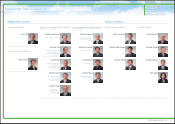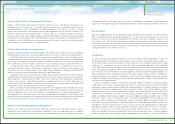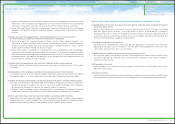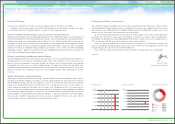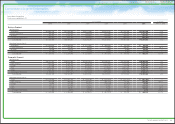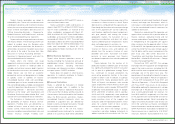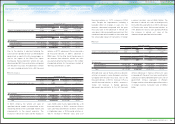Toyota 2011 Annual Report Download - page 40
Download and view the complete annual report
Please find page 40 of the 2011 Toyota annual report below. You can navigate through the pages in the report by either clicking on the pages listed below, or by using the keyword search tool below to find specific information within the annual report.
Financial Section and
Investor Information
Business and
Performance Review
Special FeatureMessage/Vision
Management and
Corporate Information
Message from the Executive Vice President Responsible for Accounting
Vehicle Sales by Region
0
5,000
10,000
15,000
20,000
25,000
(¥ Billion)
FY
(¥ Billion)
FY‘07 ‘11‘10‘09‘08 ‘07 ‘11‘10‘09‘08
0
500
-500
1,000
1,500
2,000
2,500
Japan 26.2 %
North America 27.8 %
Europe 10.9 %
Asia 17.2 %
Others 17.9 %
Net Revenues Operating Income
The three key components of Toyota’s financial strategy are growth, efficiency and stability.
We believe that the balanced pursuit of these three priorities over the medium to long term will allow
us to achieve steady and sustainable growth, as well as increase corporate value.
Growth: Sustainable growth through continuous forward-looking investments
We believe that automotive markets worldwide will grow over the medium to long term. As they expand, the
center of market growth will shift toward fuel-efficient vehicles, such as hybrid vehicles and compact vehicles,
and toward resource-rich and emerging markets. We plan to invest actively and efficiently in these areas to
respond to structural shifts in demand and ensure long-term sustainable growth. We will expand our lineup
of hybrids and other eco-cars and develop it globally, while making efforts to increase sales in emerging
markets by working to strengthen locally produced core models, such as IMVs and newly developed
subcompact models. I believe we should work to realize a geographically balanced business structure that
favors neither developed nor emerging economies.
Efficiency: Improving profitability and capital efficiency
To meet ongoing demand for hybrid and compact vehicles, we aim to provide high quality vehicles at
affordable prices and to improve profitability through further cost reductions. We will continue to slim
down our plant and equipment investment through the effective use of existing facilities and reducing
changeover costs that arise as a result of model changes. Our goal is to achieve the same effect from
minimized capital expenditures as we did when they were at their peak. Through such efforts, we will seek
effective investment that emphasizes eco-cars and emerging markets while improving our income
structure.
Stability: Maintaining a solid financial base
We preserve a solid financial base by ensuring sufficient liquidity and stable shareholders’ equity. Such a
sound financial position enables us to maintain a level of capital expenditures and investment in research
and development geared towards future growth as well as to maintain the necessary level of working
capital, even during difficult business environments such as steep price increases in raw materials or a
drastic foreign exchange rate fluctuation, not to mention such unexpected crises as the recent natural
disaster. In view of anticipated medium to long-term growth in automotive markets worldwide, we believe
that maintaining adequate liquidity is essential for the implementation of forward-looking investment to
improve products and develop next-generation technologies, as well as to establish a structure for produc-
tion and sales in both the Japanese and overseas markets in addition to the crisis measures. We will
continue to pursue further capital efficiency and improved cash flows.
We consider benefiting shareholders one of our top management priorities and make an effort to realize
sustainable growth through ongoing structural improvements to enhance our corporate value. We strive for
the continuous and stable payment of dividends while giving due consideration to factors such as the
business results in each term, investment plans and cash reserves.
To survive amid tough competition, we will utilize our internal funds for the early commercialization of
next-generation environmental and safety technologies that prioritize customer safety and confidence.
Accordingly, we declared an annual dividend payment of ¥50 per share for the fiscal year ended March 31,
2011, an increase of ¥5 per share over the previous year’s annual dividend.
Given the uncertain outlook for the present business environment, we will prioritize securing cash
reserves. Accordingly, we did not repurchase our own shares in the fiscal year ended March 31, 2011, and
we plan to forgo such repurchases for the foreseeable future.
We will continue striving to further improve profits and meet the expectations of our shareholders.
July 2011
Financial Strategy Dividends and Share Acquisitions
Satoshi Ozawa,
Executive Vice President
0729
40
TOYOTA ANNUAL REPORT 2011



